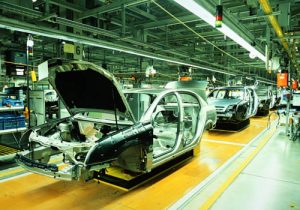As automakers race to meet federal regulations that call for higher fuel-efficiency standards — 54.5 miles per gallon by 2025, automobile manufacturers are relying more and more on adhesives to join the body parts together.
Ron Weber is President of USS Vision, a Livonia, Mich., machine vision integration and automated inspection system firm. In recent years, that trend has translated into 11 percent annual increases in the adhesive bead inspection business offered by USS Vision, whose customers include GM, Ford Motor, Chrysler and Toyota. “They’re using more of it because it [adhesive material] is superior than doing things the old way with rivets and bolts,” said Weber.

unfinished automobiles in a car plant
Companies use adhesives to make assemblies less complex, thus saving time and money. Adhesives can reduce the number of manufacturing processes, such as drilling and installing fasteners. Also, eliminating drilling or altering parts for fasteners keeps warranties from being voided.
Structural adhesives enable automotive manufacturers to create lighter-weight vehicles by using a mix of dissimilar materials, including composites, aluminum and steel. The continuous bond line also adds structural rigidity, improves safety and helps seal the vehicle from dust and moisture.
Automakers’ increased use of adhesives has spurred companies such as USS Vision to buy more cameras, and recent years have seen several machine vision equipment manufacturers roll out systems specifically geared for bead inspection. But this inspection process is complicated by a host of factors such as bead shape and color, substrate color and reflectiveness, changes in factory lighting conditions and demand for higher throughput speeds. “It’s not just a camera looking at a bead. There are a lot of variables,” said Weber. When it comes to making a lens for your specific equipment, we, at UKA design and manufacture specifically to meet your needs. We are involved in every step, as everything is done in one facility.
In today’s fast-paced, ever changing automotive industry, the use of robotic equipment is increasing. The use of robotics, and specifically, using machine vision to precisely adhere different polymers is growing. The use of adhesives is not new to the industry, as long before U.S. automakers felt pressure from the looming corporate average fuel economy (CAFE) standards set by the Obama administration and the pinch of higher gas prices, the aerospace industry in the late 1980s and 1990s had emerged as a pioneer in the lightweighting trend. Following the lead of the U.S. Air Force, which used CFRPs for its fighter planes, aerospace manufacturers began using these ultra lightweight materials for tail sections and other primary or load-bearing sections.
The aerospace industry has grown accustomed to using adhesives. But automakers, with the exception of some in Europe such as BMW, are less comfortable with adhesives, and it is up to machine vision to help build their confidence in this joining method.
Universe Kogaku designs and manufactures optical lenses for Machine Vision, security, high tech and electronic applications. We stock 1000’s of standard lens assemblies and can custom design a solution for scanners, CCTV, CCD/CMOS, medical imaging, surveillance systems, and night vision systems.